
How to appear authentic in a digital world
Online applications such as Instagram, are wonderful tools that aid in giving us an online voice, but with the increase of digital influencers and the pressure on users to reach a certain following or look a certain way before posting a photo, how authentic are we really, when our voices get lost and we succumb to Instagram rules and trends?
Authenticity and the Power of Instagram
In a digital world like today, inspiration is a key factor to success. From inspiration, we get motivation, from motivation we get determination and through determination we often earn money. Inspiration is everywhere and sometimes the most original ideas generate the most income, no matter how effortless that idea may seem. A thought grows and when that thought is put into action, it can be turned into an empire.
One example of this is how users utilize Instagram. An app where 600 million monthly users upload captioned photographs onto their accounts, Instagram is one of the many sources of online inspiration. Not only do users get to curate their own feeds, follow those who inspire them and even have the option to save photos that other users have posted, but they also establish an online identity while doing so. Defined by Wikipedia as ‘concerning truthfulness of origins, attributes, commitments and sincerities, devotions and intentions’, authenticity seems to be an incredibly broad notion and the idea of having an identity is a key factor in an online application like Instagram.
People can tell a lot about who you are, by what you post, how many followers you have, what your biography says about you and who you follow back - but how much of it is actually real?
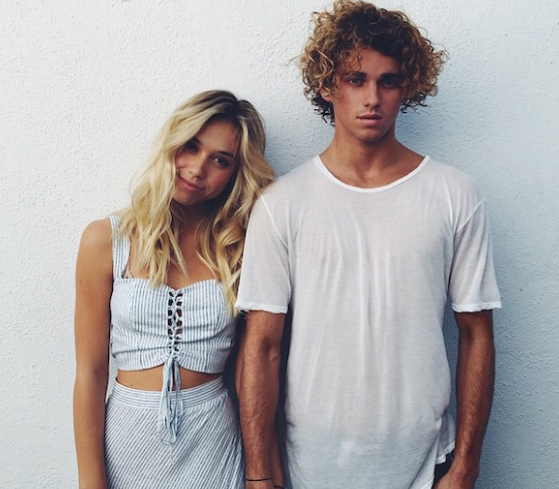
Alexis Ren (left) and Jay Alvarezz (right)
Popular users such as model and lifestyle vlogger Jay Alvarrez and model Alexis Ren are what is known as Instagram famous, a term which has been created once ‘normal’ people reach a certain following. Celebrities don’t get this title as they’re already famous for doing something else; whether it’s being an actor or a Kardashian, celebrities are a sub-group of their own. Instead, users put social media stars like Alvarrez and Ren on a pedestal because reaching their status is a much more realistic goal in the eyes of online users, no matter how long-term that may be.
It all started when Alvarrez posted a video on Youtube titled ‘Jay Alvarrez In Dream World (The Beginning)’, showing the world more about who he is, what he does and what his life consists of. The video was filmed and edited by Alvarrez and friends using drones, various cameras and professional lighting. Furthermore, the video was accessorized by expensive cars, colossal swimming pools in the backyards of luxurious houses as he portrayed his lifestyle which seemed to consist of parties with friends, trips to different countries and of course, healthy meals which aids him into fitting in with the fit community/ subgroup of Instagram.
The video received more than 8 million views which rapidly boosted Alvarrez’ Instagram following. Likes, follows and views continued to increase the more Alvarrez posted and numbers skyrocketed when he later introduced Ren as his girlfriend. Together the vlogger and model made breath-taking videos of their adventures together and posted short clips of it on Instagram and Youtube until the then-couple eventually drew so much attention that they were in multiple music videos and the faces for Pull & Bear’s 2016 summer clothing line. This meant exposure for Ren’s career as agencies took more of an interest in her and producers started wanting to work with Alvarrez due to his filming and editing skills.
"People wanted what Alvarrez and Ren had; the lifestyle, the appearances, the money, the fame and the love they seemed to have in all of their videos and photographs."
The then-couple started trending on Twitter, users recreated their photos on Instagram and they had their own section dedicated to their quintessential relationship on the online photo-sharing application called WeHeartIt. This quickly lead to a new term, ‘goals’, which pollutes nearly every comment section of a celebrity figure or Instagram famous person. People wanted what Alvarrez and Ren had; the lifestyle, the appearances, the money, the fame and the love they seemed to have in all of their videos and photographs. Though we, as the audience, realize that the footage from the videos and uploaded photographs must have taken hours to choose from and edit, this is often overlooked as the relationship seems flawless.
Questioning authenticity
Another example of how online authenticity is questioned can be seen by looking at Instagram user and Australian model, Essena O’Neill, who was quick to correct the trending term of 'goals' by saying that there should be no such thing - especially online - as everything can be edited and manipulated with a computer screen and the right equipment. She then went to further prove her point by releasing a short series of makeup-free videos explaining how much work goes into planning the “perfect” Instagram post by stating that “Social media, especially how I used it, isn’t real. It’s contrived images and edited clips ranked against each other. It’s a system based on social approval, likes, validation, in views, success in followers. It’s perfectly orchestrated self-absorbed judgment.”
O’Neill, who had 2000 Instagram pictures, deleted a majority of them and kept only 96 photos. She described the remaining photographs as “honest” and “real”. Before she deleted some of her photos, she changed the captions so that her followers could understand what really goes into a picture before it is posted on Instagram.
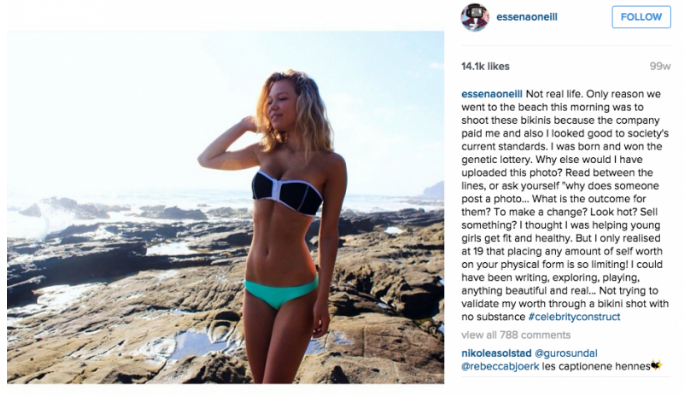
The Australian model shares with her following the truth behind her pictures on Instagram
Due to O’Neill’s statement and others like it, social media continues to be a topic that generates controversial discussion as what we see online is barely an accurate representation of our realities. The photograph posted by O’Neill raised questions about multiple topics, particularly relating to modeling as users questioned how healthy models are, how much effort the general public goes to to achieve the ‘perfect Instagram photo’ and why it is so important for us to make ourselves look good in a virtual world. We follow those lifestyles we would like to replicate, people we wish we could look like, bodies we wish we had, accounts featuring clothing, shoes, houses etc. that we wish we could own.
With Instagram, everything you post is seemingly your reality. Many users look successful, social, happy and rich in photos which is often not the case at all. What many don’t fully grasp the concept of is that, although a social media platform, Instagram is also a colossal stage for advertising, much like Youtube and Facebook. People rarely share negative moments of their lives, pictures are selected for each feed and drafts of what the Instagram page could potentially look like are curated in photography applications like VSCO in order for users to know exactly how their lives will appear to others long before they even post their pictures. Personal lives are promoted like businesses and a majority of the profit tends to come from insecurities, with instagram famous people and celebrities being the main promoters.
“Social media, especially how I used it, isn’t real. It’s contrived images and edited clips ranked against each other. It’s a system based on social approval, likes, validation, in views, success in followers."
Authenticity is a key factor as users curate feeds based on what they want others to think of them while simultaneously using these feeds to express themselves. Thus, drawing the line between what is original and what isn’t can be difficult as users within the online world influence one another in various ways. Our authentic selves often waver as we usually only share the good things that happen in our lives - whether that is a brand new car, new career, first day at a new school or university or work, getting engaged, getting married, expecting a child.
Rarely do we share the negative aspects of our lives and this could be for various reasons. For many, it is an issue of privacy as “not everyone needs to know what’s going on in my life”, but then why do we only share the good stuff? Why do we want others to think our lives are perfect and then when the truth is revealed in reality, our friends and family are taken aback because “You always looked so happy on Instagram!”, as if one image can truly capture every feeling a human is expressing in that current time period of their life.
Curating The ‘Perfect’ Feed
This isn’t to say that one cannot be original and still be inspired at the same time, but in online culture the norm seems to be almost duplicating what the inspiration is, which leads to users neglecting aspects of themselves in what they post as they’re so focused on what they want to be that they often forget who they already are. When an online identity on Instagram has been established, what we do with that identity and how we use Instagram to communicate with others is entirely up to the individual.
We start representing ourselves through different mediums such as photos, texts and captions, emojis, short videos, profile pictures and biographies which all aid in becoming our online voice, a voice we give to ourselves to tell other users how they should see us, all through what we choose to post. An online voice can be associated with the online identity, which is never a concrete nor truly authentic and original thing, as today an Instagram page could be photos of friends and white backgrounds and this evening you can delete all of it, change the username and start a completely different feed based on your new interests or who you want to be now. This ties in with self-esteem and how that is influenced by the number of followers we have and the amount of likes and comments our posts tend to generate.
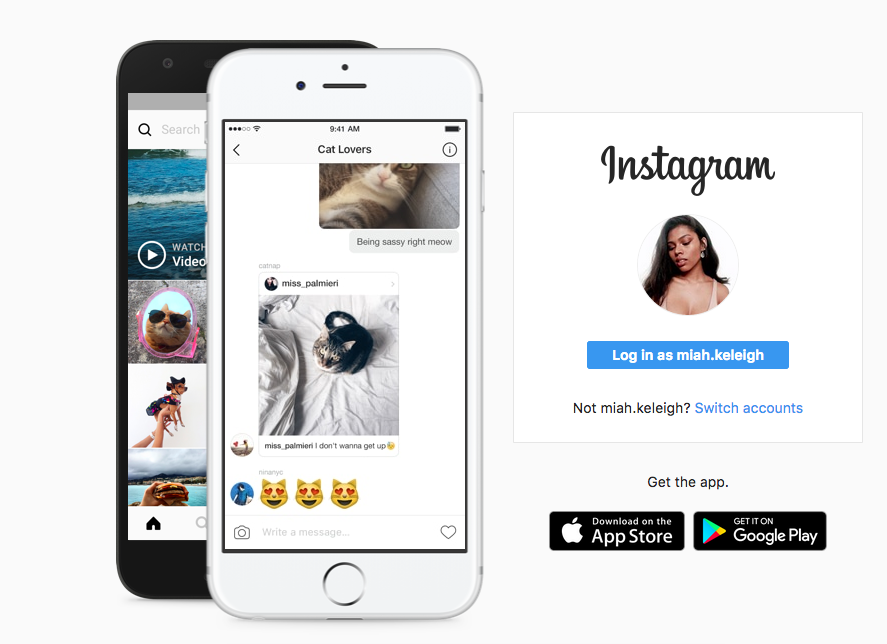
Screenshot of Instagram Login Page
Case Study 1 - Self-esteem in Relation to Social Media
A study related to self-esteem within the realm of social media was conducted by a Northeastern university where forty undergraduate students (20 male and 20 female, all 18 years and older) participated in a study that would test their self-esteem when it comes to their online personas. The researchers tested three hypotheses and utilized four scales of measurement. The hypotheses stated that
- a) Females spend more time online
- b) The more time spent on Facebook, the lower the self esteem
- c) The more time the user spends online, the lower their body satisfaction and the higher their desire to be fitter or thinner.
The four tests that were included are known as the Body Esteem Scale, the Roosenberg Self Esteem Scale (or RESS), the Eating Attitudes Test-26 (EAT26) and the Facebook Intensity Scale.
The Body Esteem Scale aims to investigate characteristics in adolescents based on their attitudes towards their appearances and certain features. There are two versions; the first is the female version which measures sexual attractiveness, weight concern and their overall physical condition. In the male version, it is categorized into the strength of the upper body, physical attractiveness and also physical condition just like with the female version. 32 questions were asked where the undergraduate students involved in the study rated rate the appearance or function of a feature of the body. The responses were then analyzed using a scale of one to five, with one indicating negative feelings and five indicating positive feelings. Higher scores indicated a higher self esteem of the body whereas lower scores indicated a lower self esteem.
RESS is a scale which measures self-esteem and self-liking. Using a similar procedure as the Body Esteem Scale, the participants were given ten general statements and asked to rate the statements on a scale from one to four, with one being strongly agree and four being strongly disagree. Statements included, “I wish I could have more respect for myself” or “I wish I was satisfied with myself.” Again, higher scores indicated a higher self esteem whilst the opposite is true for lower scores.
The third test, the Eating Attitudes Test-26, or EAT26, consists of 26 questions designed to identify symptoms of eating disorders. Examples of questions include, “I am terrified of being overweight”. A Likert scale was used, where the questions were ranked from one to six with one being never and six being always and higher scores were indicative of a higher risk of an eating disorder or at least abnormal eating habits (see Figure 3).
Questions asked in the EAT26 Test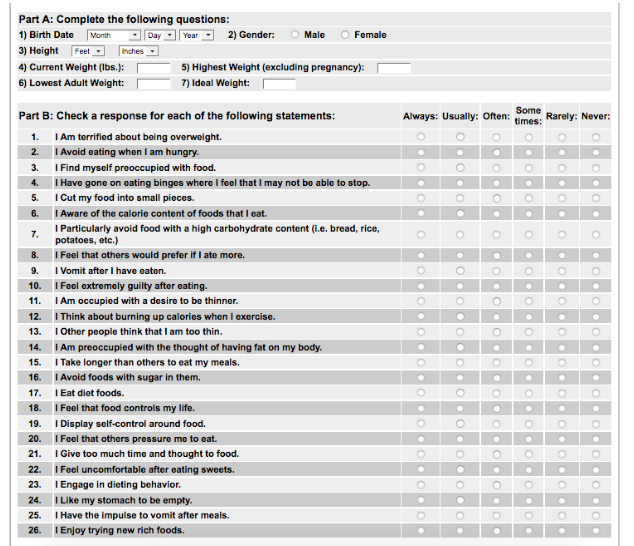
The fourth and final test, the Facebook Intensity Scale, measures the frequency of going online as well as the amount of time the user spends online. Additionally, it includes emotional connectedness to the website in mediums like status updates, emojis to express moods and the types of photographs users share as well as their daily activities. Questions like, “Facebook is big part of my daily life” are asked and again users are asked whether or not they agree with that statement by choosing a number from one to five, with one being strongly disagree and five being strongly agree. The final score is computed by calculating the mean, or average.
The design of the study included a bivariate correlational study. T-tests compared overall answers with the gender of the undergraduates, independent variables being the amount of time spent online (in this case Facebook though we could do the same for Instagram) as well as the number of Facebook friends. The dependent variables are self esteem and body esteem, as calculated by the Self Esteem Scale and The Body Esteem Scale. The undergraduate participants remained anonymous and the measurements were regulated online to see whether or not there was a correlation with the amount of time spent on Facebook as well as the number of Facebook friends and self esteem.
Results showed that females are more likely to spend more time on Facebook, which confirms the first hypothesis, and they are far more likely to be at risk of abnormal eating behaviour and that more females were unsatisfied with their bodies as shown by the overall results on the Body Esteem Scale. Females also had more friends on Facebook. The aim of this study was to see what links social media platforms, in this example Facebook, had with self esteem and body image. Moreover, the time spent online correlated with how one views oneself.
The second hypothesis which stated that the more time spent online the lower one's self esteem is also supported by this study. One reason for this could be the amount of adverts and images we are exposed to when we are online, this is especially true when seeing the results of EAT26 which indicated that females were more at risk for abnormal eating, as this comes from comparing reality to what they see online.
The study also had its limitations, mainly due to the small sample size. Only 40 people were involved, and they were all undergraduate students from a specific course which means findings are not applicable to the whole undergraduate community, let alone to larger populations. The last limitation was that researchers relied on everyone being honest, but despite the anonymity condition answers may well have been biased.
Case Study 2 - The Impact of ‘likes’ on behaviour of teenagers
The second case study is one conducted at the University of California Los Angeles, or UCLA, at the Ahmanson-Lovelace Brain Mapping Center. 32 teenagers aged 13 - 18 participated and were given the instruction that they would be involved in a photo-sharing app similar to Instagram. The researchers showed the group 148 photographs on a computer screen for 12 minutes including pictures that the participants had submitted or posted. The number of ‘likes’ the photos supposedly received from the other participants were also included, but the participants weren’t aware at the time that the likes were given by the researchers, though they were told at the end of the procedure. Additionally, the participants brain activity was analyzed using functional magnetic resonance imaging, or fMRI.
Results showed that when the teenagers recognized their own photos with a lot of likes, the activity across various regions of the brain increased. One of the important regions is known as the nucleus accumbens and involved in the reward circuit of the brain, a part that is ever changing during adolescence. When participants saw that their photos had received a lot of likes researchers noticed in the fMRI data that the social regions in the brain were linked to visual attention and gained more activation. Researchers also showed the same photo to half of the teenagers; one group saw the image with lots of likes and the other group saw the same image with less likes. More likes showed that teenagers were more prone to physically clicking ‘like’ themselves, whilst the opposite is true for the photographs that received few likes.
The researchers concluded that this is because the influence of friends, and in this case of strangers, is pressure to conform, and that this shows both in brain level and in what participants actually like. There is a desire to fit into a certain mold, which was tested when the researchers showed the teenagers neutral photos which included food, friend groups and controversial photos such as cigarettes, revealing clothes and alcohol. All three groups of photos (neutral, controversial and the photos the teenagers had submitted or posted), were linked to what is known as the Conformity Effect where teenagers are pressured to be like those around them. Even when they didn’t necessarily like the photograph they were being shown, participants still ‘liked’ it if they saw that it had a large amount of likes, once again highlighting the importance of approval in an online world.
Circling back to the case of Essena O’Neill and what her thoughts were on authenticity, it made me think about how many other people who weren’t even models felt the need to appear perfect online all the time. Granted O’Neill was getting paid for some of the images she posted and she was utilizing Instagram as her job site, many Instagram users (females in particular) take ages to decide what to post in hopes of getting a lot of ‘likes’. Instagram is a popular platform, but it can be extremely damaging to one’s self-esteem and self worth as seen in the screenshots below. One Instagram user shares how she feels after posting a picture
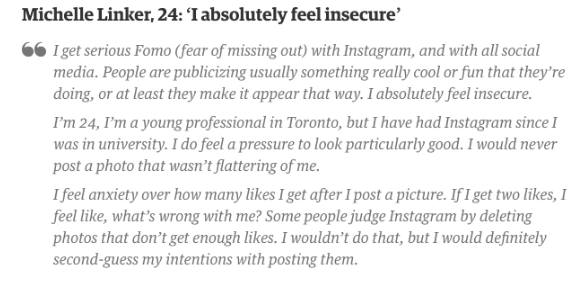
Another user says Instagram ‘can be depressing’ and it feels ‘overwhelming’.
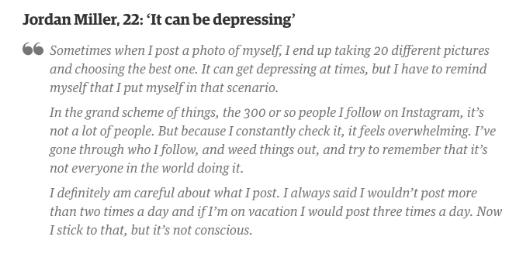
Users put a lot of effort into making their feeds look good and themselves look even better. There is something toxic about how much time we put into our online appearances - it is almost as if we are faking our own successes, especially when comparison comes into play. Celebrities are in a league of their own - regular users will never be able to compete with them for reasons that go far beyond money and include the fact that regular users don’t have a team of stylists and makeup artists and professional cameras to manufacture and capture their very best moments. Yet, despite knowing this, people let the number of likes affect the way they feel about themselves and they feel the need to change into what society deems is better. This can be as small as instagramming a photo of what you’ve had to eat, as risque as sharing a picture of yourself wearing a revealing outfit or doing your makeup for three hours to take 100 photos and post the one you think will generate the most likes. It’s a toxic system because we all practice it, some more extreme than others and everyone gets praised for it despite the lengths they go to in order to present a version of themselves that is not entirely the truth.
Analyzing My Instagram Profile
I currently have a public profile with 676 followers and I follow 258 of them back. I have uploaded 38 posts, created a short biography that consists of a sunflower emoji (an online symbol for positivity) as pictured below. From this, people who view my profile already know some things about me and by having a look at my posts, they are more aware of the kind of person I am (or appear to be ) what my hobbies or interests are, my relationships with other people and at times, even my financial status based on what I am wearing, purchases or places I am traveling to.

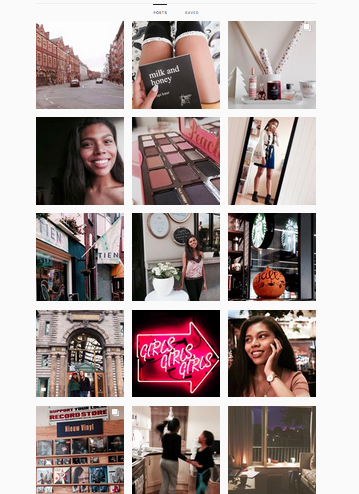
I have attached a screenshot of my Instragram feed. Many of these photos are organized, as I structured them in such a way that they would represent (somewhat of) an autumn-like feed. I share pictures of places I have been to, poetry that strikes me, buildings I admire, a book I’ve recently read and more. This section of my feed is my most recent and organized form yet; I edit certain photos by adding a filter to create contrast and that would appeal to the colder months of the year, but ironically I’m more relaxed about the number of likes my photographs get as opposed to how my feed used to look when I first started using Instagram.
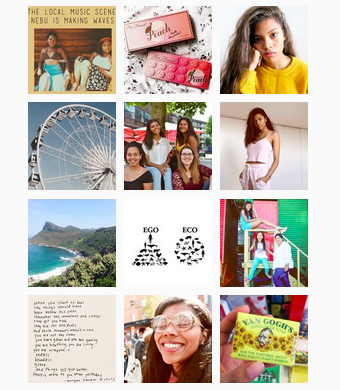
In this section of my Instagram feed, one can see it is a little less structured. I tried to maintain colour and more pictures outside in most of my photos because in this part of my feed, it was summer. Here I've shared images of myself, snippets of poetry, interviews I've done, photos of friends and family as well as places I've traveled to.
This is my favourite part of my Instagram feed as it represents who I am. My South Africanisms are clearer to see here in terms of not only where the pictures were taken but also certain quotes as captions and people who were featured. During this time, my likes ranged from 130 - 160 here, which is quite average for most active users but also more than I’ve had previously.
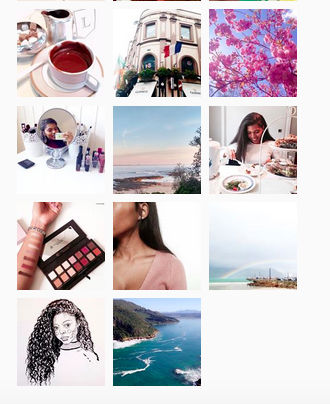
The picture above is where I first started my Instagram profile. These are my oldest posts and not much effort was put into them aside from maintaining a bright or white background. I felt most comfortable with my being in this time period as I posted a lot more photos of myself than I normally would and gave my followers on Instagram an idea of my life. Here I shared aspects of my life; my room, my favourite places, where I hang out - drawing a thin line between what is public and what is considered as private, even though I wasn't revealing too much. I didn’t fit into any particular subgroups in this section of my feed, here's not a clear message. Instead, it's simply my interests and what I enjoy or love. Again, cruelty-free beauty products are featured, travel photos, a throwback photo of my thirteen year old sister and I dancing in the kitchen (she lives on a different continent), pictures welcoming the autumn season.
I can be labelled as a traveler and art-enthusiast and even an activist, based on pictures I posted that were related to the environment and captions about sustainability. In the early days of my presence on Istagram I posted photos primarily of travel related photos I've taken which can be a subgroup within itself. Here, I didn't want to clutter my feed with photos of other people or selfies so I created a "system" where I'd share one photo of a person and then post a photo of a place or object.
In other words, when first using Instagram, there was no need to conform or categorize myself until I started using Instagram longer and realized that it came with certain norms, such as having a themed feed, only posting every once in a while and actively engaging so you don’t lose followers. The amount of pressure people create for themselves when starting a profile such as Instagram is unbelievable and incredibly time-consuming. Our cookie-cutter feeds are a pipe-dream - the only authentic versions of ourselves online are the versions that don’t care about the likes nor what we post because it is what we want to share with the world in order for them to get to know us, not for them to like us. Conforming is always a huge topic on and offline, but stressing about what a feed looks like is unnecessary as most people don’t even like themselves in real life, so why worry about what we look like in a virtual world?
"Conforming is always a huge topic on and offline, but stressing about what a feed looks like is unnecessary as most people don’t even like themselves in real life, so why worry about what we look like in a virtual world?"
Self Worth or A Need for Worth of Self?
The inspiration behind online authenticity is not rooted in the individual itself, but by a number of individuals. The individual online user often draws inspiration from the accounts the user follows. Private aspects of our identities remain, not only because of taboo or because of the abnormality of openly discussing certain topics (such as sex or death) but they may also serve as a measure of protection from receiving backlash or cyber bullying, in the comment section of a post. This has an influence on our authentic selves: who we are and who we allow ourselves to be are perceived as multiple people merged in one, depending on how we express ourselves on the social media platforms like Instagram. Despite this, the versions of ourselves we portray on social media and the individuals we are in real life are not necessarily mutually exclusive. Both of these hint at our identities and reflect our interests and aspirations.
Our online voices show the kind of people we are through what we post, who we tag in our posts and where the location is that we are posting from. The kinds of people we allow ourselves to be are influenced by not only our voices, but by the voices of others and their interests too. We absorb the information we are given and evolve with the changing trends of digital media, digital culture and what is now publically accepted. We are a society that allows for change because we are the voices of our online communities.
"How we interact and react when we get less likes than expected or fewer comments than we had anticipated tells us more about our real identities than a single photo or video ever could, as what we see online is barely indicative of reality"
For many, this is reflected through social media accounts as it is easier to show your growth online where people are more likely to see it. Though it can become a matter of status, it is also an issue of self-esteem and how one values oneself that is worthy of being discussed. Our authenticity (or what we perceive as authentic) relies on how the online user defines his or her own originality. How we interact and react when we get less likes than expected or fewer comments than we had anticipated tells us more about our real identities than a single photo or video ever could, as what we see online is barely indicative of reality.
In short, changing ourselves, deleting accounts, choosing what to post and evolving along with digital media is all good and well - as long as we do it for our own reasons. It’s no secret that the generation of today is a digital one. Technology has advanced so much that it has made actual communication less of an interaction and something that seems to be saved for special occasions, such as parties or events. Nowadays, we can meet the loves of our lives online, with a quick swipe to the right or a virtual questionnaire as we select our preferences. We are able to order clothes, food and other miscellaneous items by browsing through online pages and have them delivered to our front door within the same week. Our appearances say everything about us. What are we wearing? Or rather, who are we wearing? Where was that photo of us captured? Who were we with? Our blemishes and flaws disappear in the blink of an eye as multiple apps target our insecurities, filters gloss over imperfections and witty (previously Googled) captions aid in making us appear smart, fun and playful.
We are who we curate ourselves to be. Online we portray ourselves how we wish others to see us - but who are we in reality?